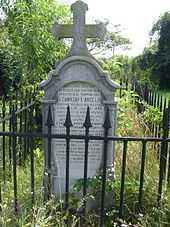Atanasie Anghel
| Atanasie Anghel Popa | |
|---|---|
| Primate of the Romanian Greek Catholic Church | |
 | |
| Church | Romanian Greek Catholic Church |
| Diocese | Diocese of Alba Iulia |
| Installed | 28 January 1698 |
| Term ended | 19 August 1713 |
| Predecessor | Teophilus Seremi |
| Successor | Ioan Giurgiu Patachi |
| Personal details | |
| Died |
19 August 1713 Alba Iulia |
Atanasie Anghel Popa, (? - † 19 August 1713, Alba Iulia) was a Romanian Greek-Catholic bishop of Alba Iulia between 1698 and 1713. He was the successor to Teophilus Seremi in the seat of Mitropoliei Bălgradului (Alba-Iulia). Through his continued efforts, he perfected the union of the Romanian Transylvanians with the Catholic Church.[1][2]
Life
He was the son of a priest from Bobâlna (today in Hunedoara county).
First synod of Alba Iulia

In 1698 he convened the "Union Synod" in Alba Iulia. The Act of Union with the Catholic Church was signed not only by Atanasie Anghel, but by all members of the Synod (38 district protopopes and 2270 priests), and sealed with the seal of the Metropolitan Archbishopric of Alba Iulia (Mitropolia Bălgradului in old Romanian language). The Diet of Transylvania, controlled by Protestants, did not look favorably upon the confessional issues of the Romanian people. Large land holders began to persecute the new Romanian Greek-Catholic priests, a situation which Atanasie Anghel had to cope with. Protestant noblemen encouraged revolts among peasants opposed to joining the Catholic Church.
Under these circumstances, the bishop Atanasie Anghel convened a new synod, also held at Alba-Iulia on 4 September 1700. This was attended not only by protopopes and priests, but also by 3 laymen delegates from each Romanian village. The 54 protopopes, together with the priests and all the delegations present, signed a new act which reinforced the decision of the synod of 1698, reaffirming religious unification of Romanians in Transylvania with the Catholic Church.
For Greek-Catholic bishop Atanasie Anghel, there followed years of hardship, being attacked by Calvinists and also by the Orthodox Archdiocese of Bucharest. Atanasie was summoned to Vienna to give explanations. Under these circumstances, on 7 April 1701 he made a statement that he no longer recognized the Archbishop of Bucharest as his superior.
Notes
- ↑ Cârnaţiu, Pamfil (1998). Biserica Română Unită două sute cincizeci de ani de istorie 1. Cluj-Napoca. pp. 25–31. ISBN 973-9288-11-1.
- ↑ "Episcopul Atanasie Anghel Popa". BRU. Archived from the original on 17 May 2011. Retrieved 17 April 2011.
Sources
Most material has been translated from the eponymous article on the Romanian-language Wikipedia.
| ||||||||||||||